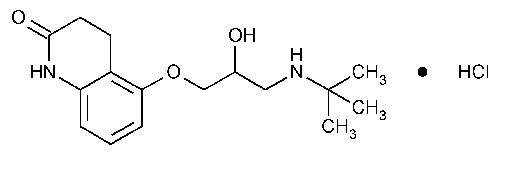Carteolol Hydrochloride
2(1H)-Quinolinone,5-[3-[(1,1-dimethylethyl)amino]-2-hydroxypropoxy]-3,4-dihydro-,monohydrochloride.
5-[3-(tert-Butylamino)-2-hydroxypropoxy]-3,4-dihydrocarbostyril monohydrochloride [51781-21-6].
»Carteolol Hydrochloride contains not less than 98.0percent and not more than 101.5percent of C16H24N2O3·HCl,calculated on the dried basis.
Packaging and storage—
Preserve in well-closed containers.
Identification—
A:
Infrared Absorption á197Kñ.
C:
Asolution (1in 50)responds to the tests for Chloride á191ñ.
pHá791ñ:
between 5.0and 6.0,in a solution (1in 100).
Loss on drying á731ñ—
Dry it at 105 for 3hours:it loses not more than 0.5%of its weight.
for 3hours:it loses not more than 0.5%of its weight.
Residue on ignition á281ñ:
not more than 0.1%.
Heavy metals,Method Iá231ñ:
not more than 0.002%.
Arsenic,Method IIá211ñ:
3ppm.
Chromatographic purity—
Standard solution A—
Prepare a solution of USP Carteolol Hydrochloride RSin methanol containing 0.5mg per mL.
Standard solution B—
Transfer 5.0mLof Standard solution Ato a 50-mLvolumetric flask,dilute with methanol to volume,and mix.
Standard solution C—
Transfer 5.0mLof Standard solution Bto a 10-mLvolumetric flask,dilute with methanol to volume,and mix.
Test solution—
Transfer 250mg of Carteolol Hydrochloride to a 10-mLvolumetric flask,dissolve in methanol,using heat or sonication if necessary to achieve dissolution,dilute with methanol to volume,and mix.
Procedure—
Apply separate 10-µLportions of the Test solutionand the Standard solutionsto the starting line of a thin-layer chromatographic plate (see Chromatography á621ñ)coated with a 0.25-mm layer of chromatographic silica gel mixture.Allow the spots to dry.Line a chromatographic chamber with filter paper,and saturate the paper with a solvent system consisting of a mixture of chloroform,methanol,and ammonium hydroxide (50:20:1).Place the plate in the chamber,and develop the chromatogram until the solvent front has moved about three-fourths of the length of the plate.Remove the plate from the chamber,and allow to air-dry.Examine the plate under short-wavelength UVlight:the RFvalue of the principal spot in the chromatogram obtained from the Test solutioncorresponds to that in the chromatogram obtained from Standard solution A.Compare the sizes and intensities of any spots other than the principal spot in the chromatogram obtained from the Test solutionwith those of the principal spots in the chromatograms obtained from the Standard solutions:no spot exceeds in size or intensity the principal spot in the chromatogram obtained from Standard solution B(0.2%),and the sum of all the impurity spots does not exceed 0.5%.
Assay—
pH6.0buffer—
Dissolve 1.34g of dibasic sodium phosphate in about 1900mLof water,adjust with 1Mphosphoric acid to a pHof 6.0±0.05,dilute with water to 2000mLand mix.
Mobile phase—
Prepare a mixture of pH6.0bufferand acetonitrile (750:250).Make adjustments if necessary (see System Suitabilityunder Chromatography á621ñ).[NOTE—Increasing the proportion of pH6.0buffer increases resolution.]
Diluent—
Prepare a mixture of pH6.0bufferand methanol (1:1).
Standard preparation—
Dissolve an accurately weighed quantity of USP Carteolol Hydrochloride RSquantitatively in water to obtain a solution having a known concentration of about 1mg per mL.Transfer 10.0mLof this stock solution to a 100-mLvolumetric flask containing 5mLof acetonitrile,dilute with water to volume,and mix.This solution contains about 0.1mg of USP Carteolol Hydrochloride RSper mL.
Resolution solution—
Transfer about 50mg of p-acetotoluidide to a 100-mLvolumetric flask,add 50mLof acetonitrile,and swirl to dissolve.Dilute with water to volume,and mix.Transfer 10mLof this solution and 10mLof the stock solution used to prepare the Standard preparationto a second 100-mLvolumetric flask,dilute with water to volume,and mix.Each mLof this solution contains about 0.05mg of p-acetotoluidide and 0.1mg of USP Carteolol Hydrochloride RS.
Assay preparation—
Transfer about 100mg of Carteolol Hydrochloride,accurately weighed,to a 100-mLvolumetric flask,dissolve in and dilute with water to volume,and mix.Transfer 10.0mLof this solution to a second 100-mLvolumetric flask containing 5mLof acetonitrile,dilute with water to volume,and mix.
Chromatographic system
(see Chromatography á621ñ)—The liquid chromatograph is equipped with a 252-nm detector and a 3.9-mm ×30-cm column that contains packing L1.The flow rate is about 1mLper minute.Chromatograph the Resolution solution,and record the peak responses as directed underProcedure:the relative retention times are about 0.8for carteolol and 1.0for p-acetotoluidide,and the resolution,R,between the carteolol peak and the p-acetotoluidide peak is not less than 3.Chromatograph the Standard preparation,and record the peak responses as directed under Procedure:the relative standard deviation for replicate injections is not more than 2.0%.
Procedure—
Separately inject equal volumes (about 20µL)of the Standard preparationand the Assay preparationinto the chromatograph,record the chromatograms,and measure the areas for the major peaks.Calculate the quantity,in mg,of C16H24N2O3·HCl in the portion of Carteolol Hydrochloride taken by the formula:
1000C(rU/rS),
in which Cis the concentration,in mg per mL,of USP Carteolol Hydrochloride RSin the Standard preparation,and rUand rSare the carteolol peak responses obtained from the Assay preparationand the Standard preparation,respectively.
Auxiliary Information—
Staff Liaison:Andrzej Wilk,Ph.D.,Senior Scientific Associate
Expert Committee:(PA5)Pharmaceutical Analysis 5
USP28–NF23Page 362
Phone Number:1-301-816-8305
